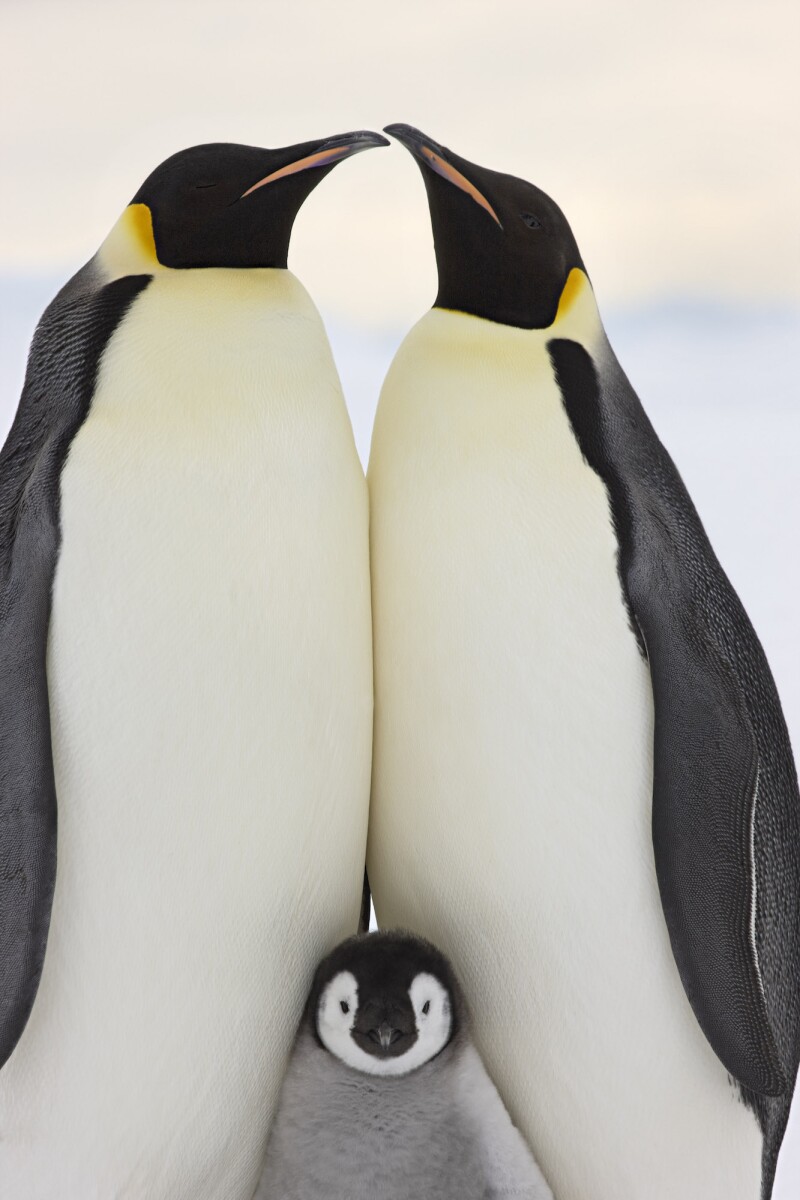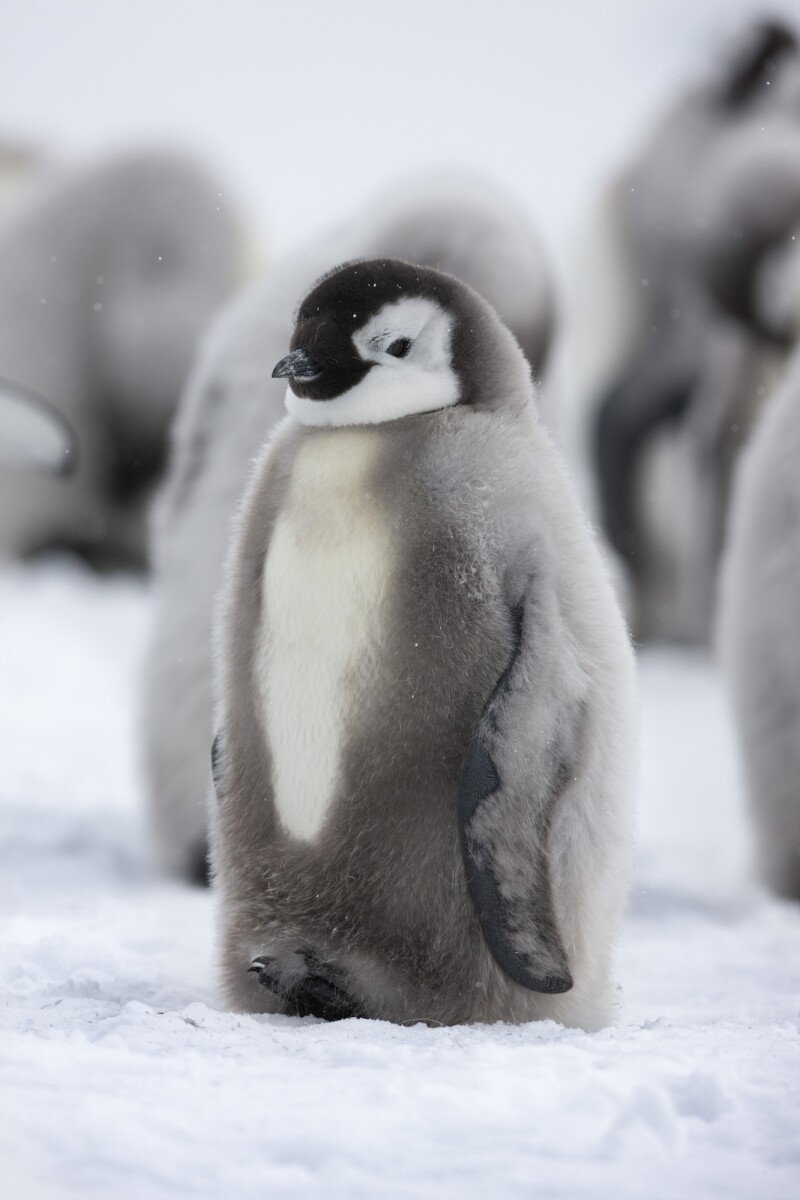A trip to Antarctica will change your life.
So says Sue Flood, an award-winning photographer who’s traveled to some of the world’s most remote corners to document wildlife and wilderness. Over the course of her career, Flood has taken approximately 50 trips to the Arctic and Antarctic. It’s not just icy landscapes that fuel her love for the planet’s polar regions—it’s a particular penguin species.
“One of the loveliest moments you can ever hope to experience is to stand in the middle of an emperor penguin colony, hundreds of miles from civilization, surrounded by the extraordinary cacophony of chicks and adults calling to one another,” she says.
Emperor penguins, the largest of all living penguin species, can only be found in Antarctica. Today, as rising temperatures reduce their breeding grounds and overfishing eliminates their food sources, emperor penguins are considered “near threatened.” Flood’s new photography book, Emperor: The Perfect Penguin, showcases the incredible ways these flightless birds survive in one of the harshest environments on Earth.

Emperor penguins have special adaptations like large stores of insulating body fat and several layers of scale-like feathers that protect them from icy winds.
Photo by Sue Flood
The book comprises a collection of 152 images shot during Flood’s many visits to Antarctica over the past nine years. Flood first traveled to the continent while working with the BBC Natural History Unit on documentary series including The Blue Planet and Planet Earth, which were presented by prominent naturalist David Attenborough. During those trips, her fascination with polar environments was fostered.

“It’s overwhelmingly touching to witness the effort that goes into raising a single emperor penguin chick,” Flood says.
Photo by Sue Flood
“You feel absolutely dwarfed when you’re standing on something like the Ross Ice Shelf—a piece of ice that’s bigger than France—or you’re standing beside an iceberg that’s the size of a Manhattan skyscraper,” Flood says. “The scale in the Antarctic is tremendous. It’s incredible.”
In 2008, 2009, and 2010, Flood worked as part of the Quark Expeditions polar adventures team and voyaged to the remote Snow Hill Island emperor penguin colony in the Weddell Sea. In 2016, she joined the Antarctic Logistics and Expeditions team for six weeks in a tented camp on the Ronne Ice Shelf, photographing and studying the world’s southernmost emperor penguin colony at Gould Bay.

Emperor penguins huddle in groups to keep themselves—and each other—warm.
Photo by Sue Flood
“Emperor penguins spend their entire lives either out on the sea ice or feeding in the Southern Ocean,” Flood says. During winter in Antarctica, temperatures can drop to -70°F, and winds on the sea ice can reach more than 90 miles an hour. But the birds are experts at surviving under these extreme conditions.
Each year, they meet to breed around the start of Antarctica’s winter in April. The female penguin lays an egg, then passes it to her male partner to keep the egg safe and warm. She then embarks on a strenuous journey to the open ocean to feed on fish, squid, and krill. When the females return to the breeding grounds (usually around July), they bring with them stomachs full of food, which they regurgitate for their chicks to eat. The female and male emperor penguins then switch duties, with the males heading out to the ocean to do their part in finding nourishment to feed their young.

Colonies consist of thousands of members, sometimes ranging up to 10,000.
Photo by Sue Flood
“It’s overwhelmingly touching to witness the effort that goes into raising a single emperor penguin chick,” Flood says.
But scientists are concerned that as climate change progresses, melting sea ice will reduce the abundance of krill—the primary food source for emperor penguins—and the birds might not be able to find enough food to build up body fat to keep both themselves and their offspring warm. “Sea ice is absolutely critical to these birds’ survival,” Flood says, as it also provides important refuge from predators such as leopard seals and killer whales.

Emperor penguins leave the colony for months at a time and travel long distances across ice to find nourishment to feed their young.
Photo by Sue Flood
For those invested in preserving the world’s polar environments, the idea of visiting them becomes complicated. Because access requires both plane trips and boat transportation, exploring these isolated areas requires contributing in some way to their pollution. However, organizations including the Association of Arctic Expedition Cruise Operators and the International Association of Antarctica Tour Operators have been established to ensure that tourism companies operating in the Antarctic and Arctic regions do so responsibly.
“I think the experience of visiting the Antarctic creates ambassadors out of the people who go there,” Flood says. “Most people are then inspired to make small changes in their lifestyles because of the things they’ve seen.”

When they’re tired of walking, emperors use their wings and claws to slide along the ice in a follow-the-leader-like procession.
Photo by Sue Flood
Flood’s images of Antarctica’s emperor penguins are also being used as part of an international campaign by the Antarctic and Southern Ocean Coalition for the creation of a nearly 700,000-square-mile marine-protected area in the Weddell Sea. If successful, this area would become the planet’s largest nature reserve.

Scientists are concerned that as climate change progresses, emperor penguins may not find enough food to build up the body fat to stay warm.
Photo by Sue Flood
“I’m paraphrasing,” Flood explains, “but David Attenborough always says that you have to show people how beautiful something is for them to want to protect it. It’s thrilling for me to be able to document the natural world. Hopefully the images in this book will inspire people to appreciate it.”
Buy it: $27, amazon.com >> Plan Your Trip with AFAR’s Guide to Antarctica











